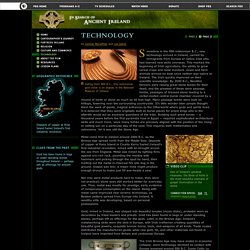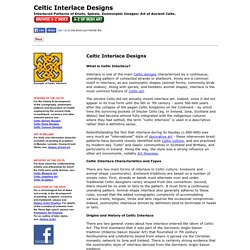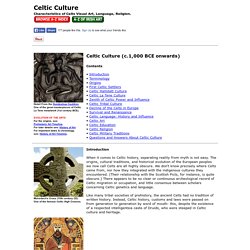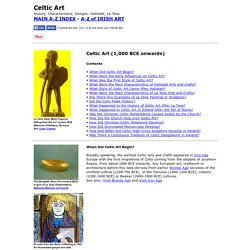

Simon James's Ancient Celts page: introduction. In Search of Ancient Ireland . Technology. By Carmel McCaffrey and Leo Eaton ometime in the fifth millennium B.C., new technology arrived in Ireland, carried by immigrants from Europe or native Irish who had learned new skills overseas.

This marked the beginning of Irish agriculture, the ability to grow cereal crops and raise livestock. Grain and farm animals arrived by boat since neither was native to Ireland. The Irish quickly improved on their scientific knowledge: By 3500 B.C., Neolithic farmers were raising great stone tombs for their dead, and the greatest of these were passage tombs, passages of dressed stone leading to a corbel-roofed central burial chamber covered by a mound of earth or stone as much as 40 feet high.
Celtic Interlace Designs. The second view maintains that Celtic interlace originated in the Middle East as part of the artistic tradition of the Eastern Roman Empire in Byzantium (Constantinople, now Instanbul).

Byzantine artists had already begun to use interlace in the development of their preferred form of two-dimensional art - the latter being fully exploited in the icons, mosaics, calligraphy and illuminations of the later Eastern Orthodox Church. The proponents of this view cite Christian Coptic (Egyptian) and Syrian illuminated texts, produced during the 5th and 6th centuries, as the true precursors of Western Gospel manuscripts like the Book of Durrow. Copies of such Middle Eastern manuscripts were probably introduced to Ireland sometime between 630 and 690 by religious envoys or missionaries returning from Rome or Siena.
Celtshistory. [Top] The Celts (pronounced with a hard C like "Claymore") appear in Europe as a group of peoples who spoke languages in the Celtic branch of the Indo-European family of languages.

Other branches of the Indo-European family are Albanian, Anatolian, Armenian, Balto-Slavic, Germanic (includes English), Greek, Indo-Iranian, Italic (Latin based) and Tocharian. BBC Wales - Education - Iron Age Celts. Gaelic. Celtic Culture: Characteristics of Visual Art, Language, Religion. Tribes of Continental Celts In Central Europe, the original European centre of Celt activity from at least 1000 BCE, Celtic tribes included the Boii, who ranged across the Czech Republic, Slovakia, Hungary, Germany and Austria; the Lugii in Poland; the Vindelici in Germany; the Cotini and Osiin Slovakia; the Eravisci in Hungary; and (from c.335 BCE onwards) the Scordisci, Latobici and Varciani in Slovenia and Croatia.

By 500 BCE, Celts were established throughout the territory of "the Gauls", an area corresponding to modern day Belgium, France,and Switzerland, as well as parts of Northern Italy and Northern Spain. In Cisalpine Gaul (the north of Italy), Celtic occupations occurred from about 400 BCE onward until Roman control was asserted fully in 192 BCE, and involved tribes such as: the Graioceles, Salassi, Seguses, Taurini, and Vertamocorii in Piedmont; the Insubres, Orumbovii, and Cenomani in Lombardy; the Boii, Lingones and Senones in Emilia-Romagna. Celtic Art: History, Characteristics. What Were the Main Characteristics of Hallstatt Arts and Crafts?

Hallstatt art from Central Europe is noted for its high quality iron tools and weaponry, along with its bronze-based manufacture of decorative items and ornamentation. But relatively few silver or Gold objects have been found from this era. Hallstatt was influenced by the militaristic Mycenean art and culture c.1650-1200 BCE which the Celts absorbed as they passed through the Black Sea area. The type-site in Austria, fully excavated by archeologists in the 19th century, included more than 2,000 graves packed with an assortment of functional and ornamental items. These and other Hallstatt-era hoards contained a mass of weaponry like axes, javelins, spears, cutting swords, daggers, helmets, bosses, shield plates.
Sccfaq. BBC Wales - Education - Iron Age Celts. Celtic Art: History, Characteristics. Simon James's Ancient Celts page: introduction.